Winter water supply from a well: an overview of the best options and arrangement schemes
Do you need your own stationary water supply system capable of providing private house water all year round? Agree that it will be very offensive to stay without water with the onset of cold weather, especially if there is a well in the suburban area that serves as a source of water intake.
You decided on your own to make winter water from a well that will be suitable for use in any weather, but don’t know the subtleties and nuances of this process?
We will help to deal with all the features - the article describes the best ways and analyzes the layout of an autonomous water supply system for year-round operation. The material is equipped with visual photographs.
Step by step the process of preparing the water supply system for winter, including the warming of all important nodes, was considered. Useful video recommendations from experienced plumbers are provided.
The content of the article:
Features of arranging a winter water supply
Winter water supply is necessary if you plan to use a water supply system from a well throughout the year.
Such an autonomous system has many advantages:
- well water with proper arrangement of the source has excellent quality characteristics and taste;
- well care can be carried out independently, without involving highly paid specialists;
- the water supply system from the well is completely autonomous and even in the event of a power outage it will be possible to extract water manually;
- to increase operational efficiency, you can use submersible pump required power.
If the arrangement of the well was carried out in accordance with all the rules, the source and the connected water supply system will last for many years.
The device of a winter water supply system has a number of its features, including:
- The presence of a warmed well or wellnot subject to freezing throughout the year.
- The need to comply with bias to prevent stagnation of water and ensuring gravity drainage during conservation.
- Preservation system, implying the possibility of a complete drain of water into the well, shutting down the pumping equipment and closing the well.
In addition, it is necessary that the layout of the pipeline takes into account local climatic conditions.
If the system is to be used during the frosty period, the pipeline must be reliably protected from freezing.

Ways to arrange a winter water supply
For a water supply system that will perform its main function - supplying water all year round, you must choose one of two options:
- Lay the water supply so that the pipes run below the depth of freezing of the soil.
- Lay pipes above the freezing horizon, but at the same time making them warm.
Both methods have their advantages and disadvantages. Let's consider them in more detail.
Method number 1 - below the freezing depth
This method is advisable to apply in the case when the freezing depth is not more than 150 cm. In this case, the value of the freezing depth is determined on the basis of data for the last 10 years.
It is also worth considering that very cold winters occasionally occur when the ground freezes below. Based on this, it becomes clear that the laying of pipes should be carried out to a depth equal to the depth of freezing of soil in the region plus 20 - 30 cm.
The water supply device begins with the excavation of a trench of the required depth from the well to the point of entry of the water supply into the house.
At the bottom of the trench sand is poured with a layer of 10 cm and water pipes are laid. The trench is filled with earth, soil at the site of filling is compacted.
Despite the fact that this is the easiest and cheapest way to create a winter water supply system from a well, there is a problem with the choice of pipes: polyethylene pipes will not work here, because they will not withstand the mass of soil pressing from above, and metal pipes (steel) will corrode.
The problem can be solved by treating the pipes before installation with an anti-corrosion compound.
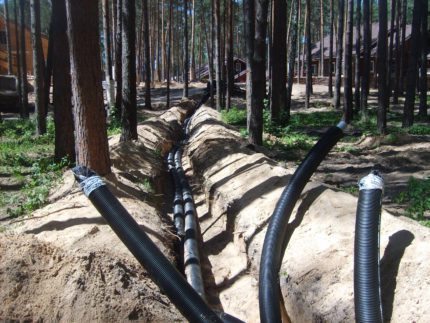
In addition to the problem with the choice of pipes, this method of installing a winter water supply system has several more disadvantages:
- when carrying out repair work there is a need for a large amount of earthwork;
- the difficulty of finding a damaged section of the pipeline;
- the probability of freezing and rupture of pipes in the water supply system in case of insufficient deepening of the water supply system.
To minimize the number of accidents in the water supply system, it is recommended to make as few pipe joints as possible, since it is at the joints that leaks most often occur.
Also, when installing a winter water supply system below the level of seasonal freezing, it is necessary to carefully monitor the tightness at the junction of the water supply pipes to the well.
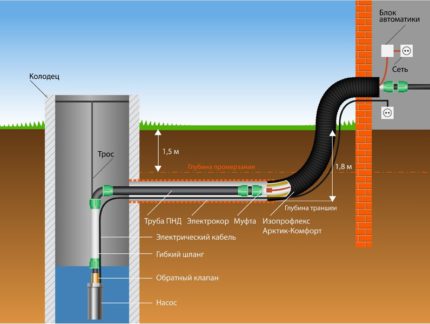
Method number 2 - insulation of the water supply
With this method, the water supply is buried to a depth of 40-60 cm, but the pipes are laid in a trench insulated.
For the northern regions, it would be advisable to lining the trench with brick or cellular concrete blocks to increase the heat preservation.
Of course, this will significantly increase the cost of building a winter water supply, but it gives a 100% guarantee against freezing.
From above, such a trench is covered with concrete slabs and covered with soil. Pipes for the installation of insulated water pipes are usually used the most common: polymer low pressure and a suitable diameter.
What insulation to use? Two options are possible here:
- hard heat-saving shells from foam or extruded polystyrene foam (“shell”);
- soft thermal insulation materials (foamed polyethylene options, mineral and basalt wool with externally water-repellent protection).
When choosing a heat-insulating material for pipes, attention must be paid not only to its cost and ease of use, but also to its physical properties.
For example, mineral wool is an inexpensive and easy-to-install insulation, but has high water-absorbing properties, which means that it must be used with the mandatory installation of a vapor barrier layer.
Basalt wool based on sedimentary rocks is a rather heavy insulation that cannot be used for pipes of small diameter.
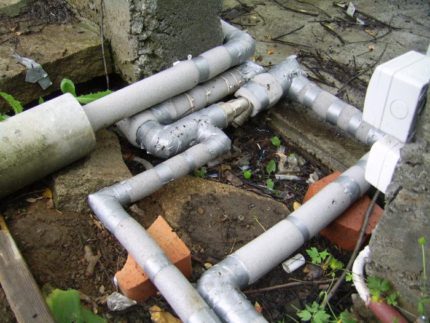
For filling trenches with insulated pipes, it is best to use not excavated soil, but crushed stone or expanded clay.
These materials have a lower coefficient of thermal conductivity than soil, and therefore provide a longer heat retention.
Organization of winter water supply
The winter water supply system in its composition is not much different from summer water supply. It also includes the following elements: pump, water pipes, storage tank or accumulator, drain valve.
At the same time, the design of the winter system requires compliance with certain rules.
Step # 1 - we insulate the pump for water supply
The pump and its power cable need to be insulated. For thermal insulation of the pumping station, you can use ready-made heat-insulating systems or build a casing yourself using mineral wool, polystyrene foam or other heaters.
The junction of the pump and water pipes (pit) also requires insulation. Typically, the size of the pit is 0.5 x 0.5 x 1.0 m. The walls of the pit are lined with brick, and the floor is covered with a layer of crushed stone or concrete screed.
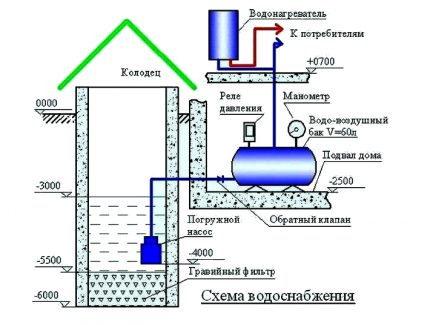
How to choose a pumping station read in this article.
Step # 2 - insulating the accumulator
Storage tank or accumulator must also be insulated. The tank acts as a drive, allowing the water supply system to run smoothly.
In the absence of a storage tank, the system will periodically shut down, which will lead to wear of all its elements.
For thermal insulation of the accumulator, you can use the following types of insulation:
- polystyrene or expanded polystyrene;
- mineral and basalt wool;
- polyurethane foam and foamed polyethylene;
- small-mesh rolled heaters with a foil layer.
The process of insulation consists in the device of the external casing of the accumulator, followed by finishing with the final material, if necessary.

Step # 3 - take care of the water pipes
For an insulated winter water supply with a laying depth of 40-60 cm, the best option would be to choose low-pressure polyethylene pipes.
In comparison with metal, they have the following advantages:
- not subject to corrosion;
- low specific gravity;
- easy to install;
- much cheaper in cost.
The diameter of the pipes is calculated based on the planned water consumption at the design stage of the water supply system.
Water consumption depends on the number of people living in the house, the availability of water-consuming devices, the amount of water used for watering and caring for animals and other factors.
For example, a pipe with a diameter of 25 mm has a throughput of 30 l / min, 32 mm - 50 ml / min, 38 mm - 75 l / min. Most often for country houses and country houses with an area of up to 200 m², HDPE pipes with a diameter of 32 mm are used.
And read more about how to choose a heater for water pipes Further.
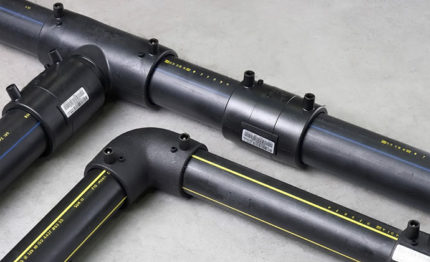
Step # 4 - set the drain valve and pressure switch
A drain valve is needed to preserve the system, thanks to it, water can drain into the well. With a small length of water supply, the drain valve can be replaced by a bypass drain pipe.
The relay performs the function of maintaining pressure in the water supply, ensuring its uninterrupted operation and preventing breaks and stagnation of water. At achievement of the maximum indicator of fullness of pipes pressure switch will turn off the pump.
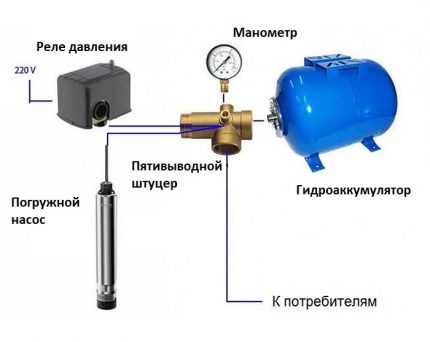
Small installation tricks
Work on the device begins with the preparation of a scheme (project) of water supply. The diagram clearly shows the path that water makes from the water intake point to the wiring point of the water supply system in the house.
The wiring in the house can be performed in two ways:
- consistentwhen a pipe is laid along the entire house and several water consumers leave it;
- collectorin which a separate pipe is drawn to each water consumer.
The first method is recommended to be used if the house does not have powerful sources of water consumers and 1-3 people live.
In the presence of a washing machine, watering hoses, automatic watering and irrigation systems, when living in a house of more than 3 people, a collector water supply system is recommended, which ensures sufficient pressure for comfortable water use.

The technology for the construction of the winter water supply will be as follows:
- Development of a water supply scheme. The choice of pipe materials and their laying depth.
- Digging trenches under pipes.
- Installation of pumping equipment, hydraulic accumulator.
- Pipe connection with pumping equipment and a hydraulic accumulator.
- Insertion of the intake pipe into the well.
- Installation of insulated pipes from the well to the house.
- The layout of the water supply system inside the house.
Installation of pipes from the well to the house is carried out using special bends - short pipes with threads at the ends. The squeeze is pressed against the pipe by flanges or fitting adapters.
Both designs must be carefully sealed to prevent leaks. HDPE pipes are interconnected by means of soldering or fittings.
Joints must be treated with silicone sealant. Processing with bitumen and mastic is prohibited!
The immersion depth in the well of the intake pipe of the surface pump should fall just below the water level or not less than 50 cm from its bottom. When lowering to the bottom, the elements of the bottom filter will be sucked in.
Before installing the intake pipe, water is pumped out of the well to ensure that it can be sealed to the elbow of the outlet pipe from the well.
It is advisable to equip the knee with a faucet for the possibility of shutting off the water supply during repairs.
Pipes from the well are laid with the creation of a slope towards the well, to ensure drainage of water from the water supply system during conservation work.
The slope can be controlled using the building level. To ensure gravity drainage, it is enough to observe a slope of 2 degrees.
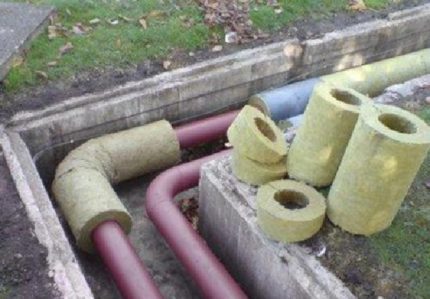
Another way to create a winter water supply system is the method of heating pipes. To do this, a heating cable or plates are used that are mounted along the pipes or wound in a spiral.
The device of such a cable is advisable if the site is uninterruptedly supplied with electricity.
When the power is turned off, the non-insulated pipe will immediately freeze and the water supply will fail.
The best option can be considered a combined method in which the insulated pipes are heated heating cable. In this case, the cable will consume the minimum amount of electrical energy.
An innovative way of a water supply device
More recently, a new method has been developed to create a winter water supply system based on the use of flexible polymer pipes insulated by an industrial method.
There is a waterproofing layer on top of the insulation shell of such pipes, and a special channel is made along the surface of the pipe for laying the heating cable, which greatly simplifies installation and shortens the installation time of the water supply.
The pipes are flexible and are delivered in bays, so that the number of joints can be minimized, and the risk of leaks and the need for repairs can be minimized.
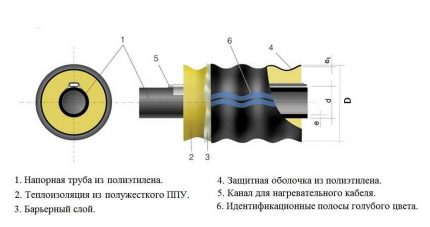
Conclusions and useful video on the topic
Installation of finished heat-insulating elements on pipes before laying them in a trench:
Winter plumbing in a private house:
Installation of heating cable:
The installation of a winter water supply system is a simple process that allows you to continuously receive water throughout the year. The basic principle of creating a winter water supply system is to prevent freezing of pipes and system elements.
This can be done by installing a thermal insulation system using heat-insulating materials or by laying pipes below the level of soil freezing. The choice of method depends on the climatic conditions of the terrain, landscape and hydrogeological features of the site, as well as on the personal preferences of the owner.
If you have the necessary knowledge or skills in arranging a winter water supply system from a well, please leave your comments in the block below. There you can ask questions of interest on the topic of the article.

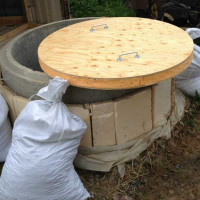 Do-it-yourself well warming for the winter: an overview of the best materials and methods of warming
Do-it-yourself well warming for the winter: an overview of the best materials and methods of warming 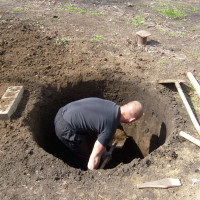 Digging a well with your own hands: types of well structures + an overview of the best digging technologies
Digging a well with your own hands: types of well structures + an overview of the best digging technologies 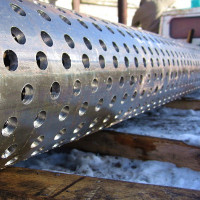 How to make a do-it-yourself filter for a well: an overview of the best home-made options
How to make a do-it-yourself filter for a well: an overview of the best home-made options 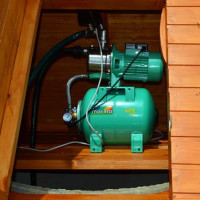 How to make water supply in the country from the well with your own hands: we carry water into the house
How to make water supply in the country from the well with your own hands: we carry water into the house 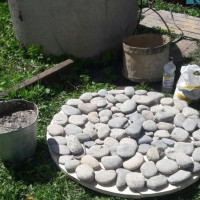 Well bottom filter: arrangement technology and overview of filtration materials
Well bottom filter: arrangement technology and overview of filtration materials 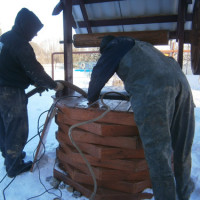 Water purification from a well: an overview of the best and most effective ways
Water purification from a well: an overview of the best and most effective ways  How much does it cost to connect gas to a private house: the price of organizing gas supply
How much does it cost to connect gas to a private house: the price of organizing gas supply  The best washing machines with dryer: model rating and customer tips
The best washing machines with dryer: model rating and customer tips  What is the color temperature of light and the nuances of choosing the temperature of the lamps to suit your needs
What is the color temperature of light and the nuances of choosing the temperature of the lamps to suit your needs  Replacement of a geyser in an apartment: replacement paperwork + basic norms and requirements
Replacement of a geyser in an apartment: replacement paperwork + basic norms and requirements
When installing the water supply system, the builders hired by us laid the water supply system above the freezing level - we have warm winters, and it turned out to be more economical. In addition, the site at the input of the system into the basement of the house was poorly insulated. As a result, they sat almost without water in the winter, tried to heat the pipes with a soldering iron - the very first frost turned into ice plugs in the pipes, in the spring they all reworked. They didn’t dare to save anymore.
For this, it is necessary that the pipeline from the well to the house be sufficiently protected from frost. Again, consider the climatic conditions: either it is Siberia, or the South of Russia. The slope must be observed so that water can be freely drained from the system before it is conserved. Pipes are laid deeper than the level of freezing of the soil, it is possible, of course, even higher, but then you will have to completely warm the outer water branch. When we equipped our system, we dug a trench to a depth of 1 meter, which is 20 cm more than the freezing depth, and laid pipes. Only the site was insulated before entering the water supply into the house. Pump station in a heated utility room.
In Siberian conditions, it will not be possible to bury me below the freezing depth, I have to warm something. I think about the heating cable.